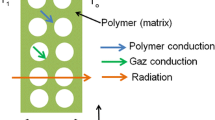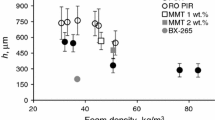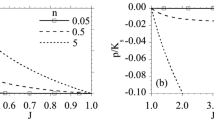Abstract
Porous plastics are used in various fields of industry, including radio- and electrotechnical fields. They are characterized by good heat- and sound proofing, dielectric and mechanical properties, and resistance to various external factors during operation. The problem of predicting the effective permittivity of foam-polymer materials with a large volume fraction of pores, in particular, polyepoxide foam materials, are considered. Two methods for solving it, both based on the matrix composite model are proposed. In the first method, the matrix is considered as a polyepoxide binder, and cavities filled with gas are taken as inclusions. In the second method, polyepoxide walls separating cavities are taken as inclusions, and gas filling cavities are considered as a matrix. To obtain the calculation formulas, the generalized singular approximation of the random field theory is used in both cases. Based on the derived expressions, model calculations of the effective permittivity are performed for macroscopically isotropic foam plastic with polymer binder based on ED-20 and cavities filled with freon, depending on the apparent material density. The calculations in the generalized singular approximations are performed for the case where the matrix is considered as the reference medium and using the self-consistent method. In the calculations using the second approach, two shapes of material cells are considered, i.e., weakly leaked and heavily leaked polyhedron. The dependences calculated by all methods show qualitative agreement with the experimental data.

Similar content being viewed by others
REFERENCES
V. Yu. Chukhlanov, Yu. T. Panov, A. V. Sinyavin, and E. V. Ermolaeva, Gas-Filled Plastics (Vladim. Gos. Univ., Vladimir, 2008) [in Russian].
A. A. Berlin and F. A. Shutov, Foam Polymers Based on Reactive Oligomers (Khimiya, Moscow, 1978) [in Russian].
A. N. Trofimov, Doctoral (Tech. Sci.) Dissertaton (Moscow, 2018).
V. S. Zarubin, G. N. Kuvyrkin, and I. Yu. Savel’eva, Radiooptika, El. Zh., No. 3, 29 (2016).
T. D. Shermergor, Theory of Elasticity of Micro-Inhomogeneous Media (Nauka, Moscow, 1977) [in Russian].
V. V. Bardushkin, I. V. Lavrov, V. B. Yakovlev, and E. N. Yakovleva, Oboron. Kompleks-Nauch-Tekh. Progr. Ross., No. 1, 58 (2013).
A. G. Fokin, Sov. Tech. Phys. 18, 44 (1973).
M. I. Zavgorodnyaya, I. V. Lavrov, and A. G. Fokin, Izv. Vyssh. Uchebn. Zaved., Elektron., No. 5, 3 (2014).
C. Bohren and D. Huffman, Absorption and Scattering of Light by Small Particles (Wiley, New York, 1998).
I. Z. Chernin, F. M. Smekhov, and Yu. V. Zherdev, Epoxy Polymers and Compositions (Khimiya, Moscow, 1982) [in Russian].
Chemical Encyclopedy, Ed. by N. S. Zefirov (Bol’sh. Ross. Entsiklopediya, Moscow, 1998), Vol. 5 [in Russian].
D. A. G. Bruggeman, Ann. Phys. 24, 636 (1935).
Funding
This study was supported by the Russian Foundation for Basic Research, project no. 20-08-00155-а.
Author information
Authors and Affiliations
Corresponding author
Additional information
Translated by A. Kazantsev
Rights and permissions
About this article
Cite this article
Lavrov, I.V., Bardushkin, V.V., Yakovlev, V.B. et al. Prediction of the Effective Permittivity of Foam Polymer Materials. Semiconductors 55, 1021–1023 (2021). https://doi.org/10.1134/S1063782621130078
Received:
Revised:
Accepted:
Published:
Issue Date:
DOI: https://doi.org/10.1134/S1063782621130078




